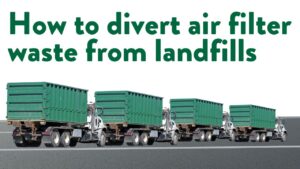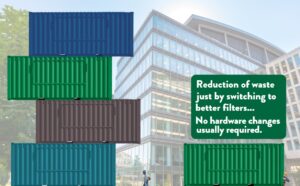Air filters play a crucial role in maintaining indoor air quality, which in turn promotes better cognitive health, enhances productivity in schools and workplaces, and contributes to the overall well-being of building occupants. Along with the positive health implications, there is a growing need to consider environmental impact in all aspects of our activities. It is essential to understand the extent to which air filters affect the environment, both positively and negatively. Can using the right air filters significantly reduce a building’s carbon footprint? How can we minimize the waste generated by discarded air filters while maintaining good indoor air quality? These questions and more will be addressed in this article.

The positive and negative environmental impacts of air filters
Positive environmental impacts of air filters
Air filters and indoor air pollution reduction
It is crucial to know what you are getting when it comes to air filters. For example, health authorities in the U.S. and Canada have established that an air filter with a minimum rating of MERV 13 should be used when we seek to improve the indoor environment, protecting the health of building occupants. ASHRAE currently recommends using “a minimum MERV 13 filter, which is at least 85% efficient at capturing particles in 1 µm to 3 µm size range.” That is because particles in the PM2.5 and PM1 range are the most harmful to human health as they more easily penetrate the body’s defence mechanisms. High-quality air filters can have a very positive effect on IAQ and health.
Air filters also play a very positive role in the environment when they are engineered to save energy and last longer. Filters designed to have a lower average pressure drop over their lifetimes result in much less waste and they generate less greenhouse gas release in production, transportation for new filters, and disposal of old filters. Filters designed to use less energy when coupled with variable frequency controlled fans (VFDs) can reduce building operating costs related to energy and reduce a building’s carbon footprint.
High-efficiency air filters make the building healthier for occupants by removing particulate matter. According to Environmental Protection Agency (EPA) studies, indoor air can be up to five times more polluted than outdoor air.
For equipment protection
High-quality air filters help maintain optimal performance, ensure good airflow, prevent contaminant buildup, protect sensitive components, and reduce wear and tear on HVAC systems decreasing maintenance and the need for hardware replacement.
To prevent nuisance odours and pollutant gases from escaping facilities
Air filters prevent odours from cannabis production facilities from spreading into the community. They also protect the indoor environment and staff in facilities such as gas plants, pulp and paper production facilities, and waste treatment facilities.
Negative impacts of air filters on the environment
The most important things to consider when evaluating the negative impacts of air filters are 1. the unexpected results of using an improper filter and getting poor indoor air quality; 2. filters that may not be designed to last long because they load with particulates too quickly and have to be replaced more often, creating more waste and requiring increased transportation for delivery of new filters and disposal of old filters, creating more carbon gases.
Air filters create waste
Some components of air filters, such as dirt-loaded media, are not recyclable, while others, such as plastic or metal frames, are. Some buildings and facilities use a great deal of air filters and end up with a lot of waste that goes to landfills. How much waste from air filters at the end of their lives is diverted from landfills can be measured with environmental, social, and government (ESG) scores.
Negative impacts of using an improper air filter
Indoor environments can suffer from poor indoor air quality, and this can have a negative impact on employees at workplaces, students and teachers in schools, and users of facilities such as recreation centres and public buildings, as well as building occupants. This happens most when people think they are being protected by inferior air filters, low MERV-rated filters, improperly installed or damaged filters, or filters that are not properly tested, i.e. filters without ASHRAE 52.2 testing.
Air filters evolve
As time went by, from the 1940s to the present, it was discovered that some filters were much more effective in protecting people, the environment, and equipment than others. Also, specialized air filters were created for use in the nuclear industry to trap radioactive particles. In the late 1960s, air filter testing standards were established by The American Society of Heating, Refrigerating and Air Conditioning Engineers (ASHRAE). ASHRAE came up with MERV ratings for air filters in the late 1980s, and they served as a widely adopted basis for comparing one filter to another. ISO 16890, Europe
Now, air filters can be evaluated based on their capability and efficiency based on MERV ratings as long as the ASHRAE 52.2 standard is utilized.
Solutions for reducing air filter waste
For homes and buildings, it is best to use a MERV 13-A filter or higher. The MERV-A distinction ensures that you will actually get an air filter with maintained efficiency.

A low-quality air filter will likely not be designed for energy efficiency and will thus require more energy when used in conjunction with a VFD-controlled fan that can ramp up during building or facility opening hours and slow down during hours that it is closed. A high-quality air filter will use far less energy and will emit less carbon gases.
A low-quality, cheap air filter will require far more filter change-outs and produce much more waste. For example, low-quality pleated filters must be replaced roughly every three months, whereas the highest-quality pleated filter can last nine months to a year or more.
How to choose an environmentally friendly air filter that reduces waste
Many types of eco-friendly air filters can reduce waste, last longer, use less energy, and improve your ESG scores.
Washable air filters
Some air filters are washable. These washable filters need a lot of maintenance to be in proper working order. The central negative aspect of washable filters is that they are low in real-world MERV efficiency and, thus, cannot adequately protect the indoor environment. Washable air filters also require a lot of water to clean. After a few washes, these filters can suffer from significantly reduced efficiency. Also, washable filters have a high initial cost, and usually, a second set is required when filters are frequently serviced, washed, and dried. Washable filters are best suited for very large contaminants that may clog standard filters.
Camfil solutions for reducing air filter waste
Camfil advises purchasing air filters designed to last much longer. For example, some air filters can last from nine months to over a year, while some commercial air filters can last up to five years. This represents a significant reduction in the amount of waste generated by air filters. Furthermore, air filters can be recycled, which can also positively impact sustainability by significantly reducing waste.
Energy usage
One of the best ways air filters can be eco-friendly and help reduce your environmental impact is by being much more energy efficient. Air filters designed to use less energy can have a substantial positive impact on the environment. Filters which work well with VFD-controlled fans can cut energy costs and carbon gas output.
Recycling air filters


Recycling air filters in conjunction with using the longest-lasting filters is a great solution to drastically reduce air filter waste. Camfil is constantly striving to innovate to make air filters more recyclable. Dirt-loaded media can be removed from filters at the end of their life, and metal or plastic frames can be recycled and used to make new products such as park benches. Recycling can divert a large amount of materials from landfills.
Camfil waste diversion
Waste diversion is the process of using source reduction, recycling, reuse, or composting to avoid and reduce waste generation. Many economic, social, and environmental advantages result from waste diversion, such as energy conservation, elimination of waste from landfills and other disposal sites, and lowering disposal expenses.
Future trends in air filtration technology
Creating energy from air filter waste
Materials that cannot be recycled, such as contaminant-loaded media, can be converted to energy when they are safely combusted, and scrubbers are used to capture and neutralize harmful emissions. Steam created by heat in combustion is used to power turbines, generating electricity.
Innovating to reduce waste and make air filters more easily recyclable
Camfil is constantly innovating to reduce waste by increasing air filter longevity and making filter components more easily recyclable in its research facilities.
Summary
Air filters are essential for maintaining clean air and protecting HVAC equipment, offering benefits like reduced indoor air pollution, improved health, and increased productivity. However, the production, transportation, and disposal of air filters pose environmental challenges, including a lot of waste that may end up in landfills and the negative consequences of using cheap filters, such as poor indoor air quality and much more waste that can adversely affect the environment. It’s essential to consider the environmental impact of air filters, including their recyclability and the potential for increased waste and transportation demands associated with frequent replacements.
To reduce your building’s air filter waste, contact us today. Please use this contact form
About Camfil Canada Clean Air Solutions
For more than 60 years, Camfil has been helping people breathe cleaner air. As a leading manufacturer of premium clean air solutions, we provide commercial and industrial systems for air filtration and air pollution control that improve worker and equipment productivity, minimize energy use, and benefit human health and the environment. Read more about Camfil Canada
##
Media Contact:
Phillip Ilijevski
Camfil Canada Inc.
T: 437-929-1161
